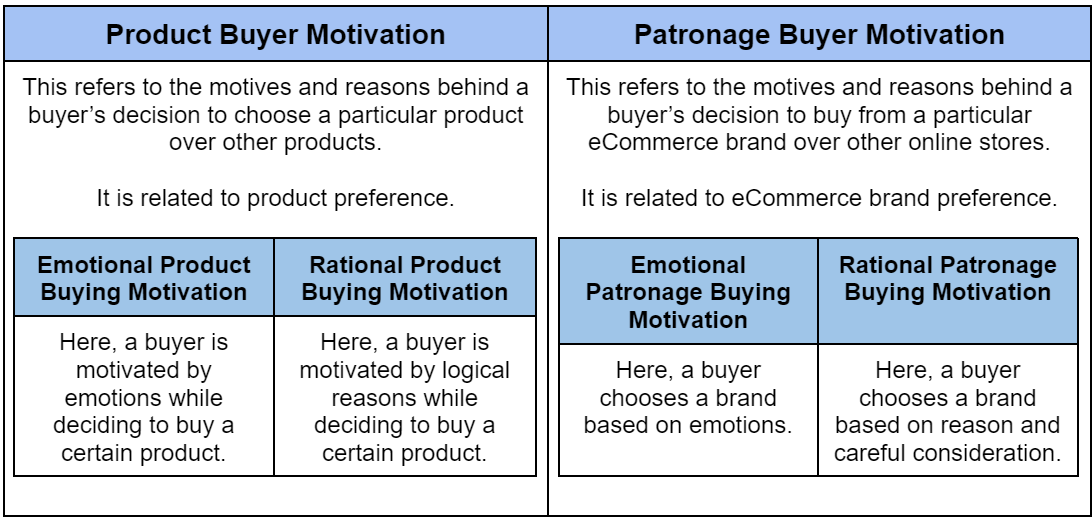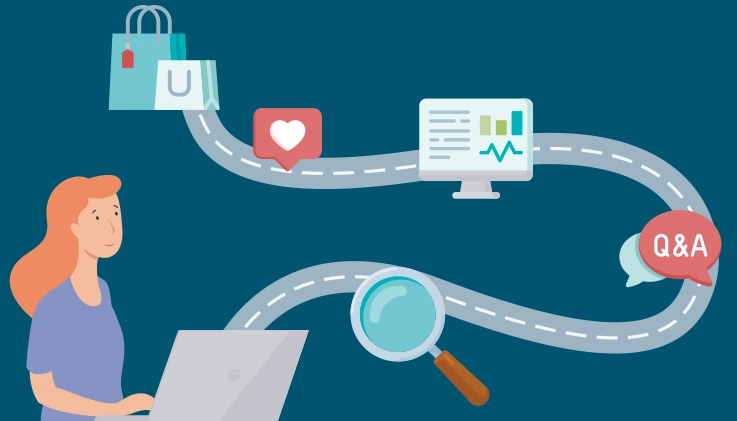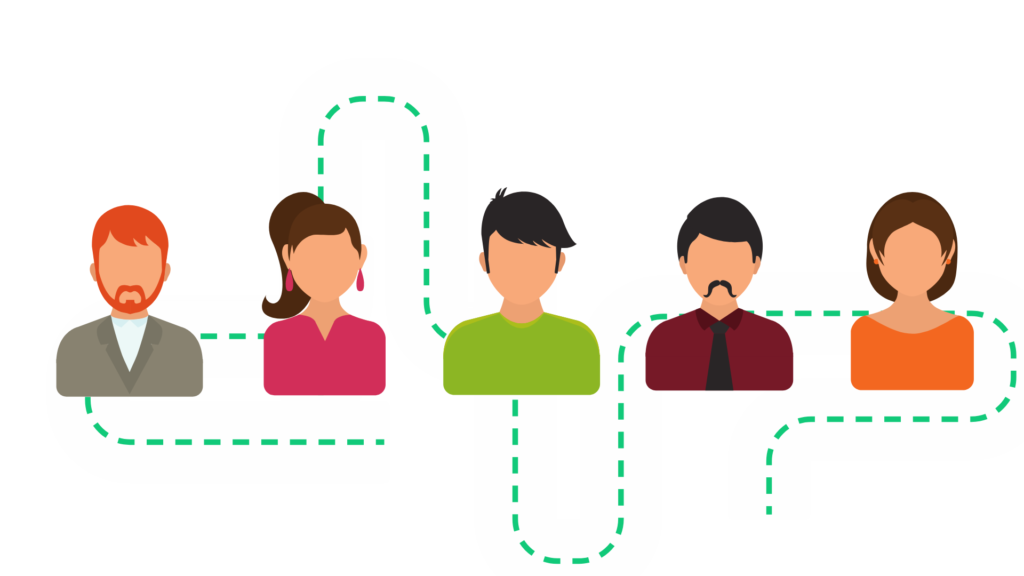A Complete Guide on Buyer Motivation For E-Commerce: Types & Tips To Boost Sales
Have you ever wondered why buyers buy from your online store? What sparks their decision to purchase a certain product or try a particular service? What is the motivation behind it? Is it thoughts? Feelings? Instincts? Or something else?
If these thoughts ever crossed your mind, you are not alone. E-Commerce businesses are constantly trying to discover the motives behind buyers’ purchasing behaviors. This can be a challenging task for eCommerce marketers; however, it is critical for implementing better customer segmentation and understanding the exact needs and wants of customers. This allows marketers to better position their products or services and to effectively engage customers at every stage of their customer journey.
In this article, we are going to walk you through the meaning of buyer motivation, why it is important to understand it, the types of buyer motivation, and some tips on how to use buyer motivation to boost the sales of your online store.
Table of Content:
- What is buyer motivation for eCommerce?
- Why is it important to understand buyer motivation for eCommerce?
- Types of buyer motivation
What is Buyer Motivation for E-commerce?
Buyer motivation, also known as buyer’s motives, can be defined as the psychological factors that influence customers’ decisions to buy a product or try a service from your online store. Whether these factors are thoughts, feelings, instincts, or others, they are the main forces that drive, encourage, and motivate customers’ urge to buy.
In other words, buyer motivation is the main driving force behind the conversions of your online store. It consists of all the psychological factors that make your prospects turn into actual customers.
Why is It Important to Understand Buyer Motivation for Ecommerce?
Today, eCommerce businesses need to understand buyer motivation because the process a potential customer goes through to become an actual customer of your online store is not as easy as it used to be. It has become longer and a little more complicated.
Traditionally, marketers have described how customers find your business online with the image of a funnel. The assumption is that a large group of users find your company, go through increasing engagement levels, and then ultimately buy your product. The funnel image implies a direct route from becoming aware of a product to purchasing it.
However, today, there is no longer a single path from awareness to sale. That is why eCommerce marketers today have moved away from the funnel concept and closer to what we now call “the customer journey”. The customer’s journey can be described in different ways, and its stages can have different names; however, one of the simplest ways to name the stages is as follows: awareness, interest, desire, action, and post-action.
It is important to know that this journey is not necessarily linear. Customers can walk this path back and forth. Buyers’ motivations differ from one stage to another, and your interaction with customers as an eCommerce marketer can start at different points of their journey; therefore, you should clearly understand these motivations to be able to deal with your buyers during each stage of their journey.
Customer journey stages:
- Awareness: This stage refers to how and where a customer first becomes aware of you. Here, your efforts should be focused on establishing your online brand and letting customers know who you are and what you do.
- Interest: In this stage, a customer already knows about you and is interested in your offer. Now, you want to inform this customer about your products or services.
- Desire: In this stage, the customer does not just know about you but also wants to buy your products or services. Here, your marketing should be focused on convincing customers why they should buy these products or services from you and not from the competitors.
- Action: When a customer reaches this stage, they already know about you, want the thing you have to offer, and are ready to take action. In this stage, you want to make the customer as comfortable as possible while taking action.
- Post-Action: This is the stage when a customer has already taken action and it describes how you interact with this customer afterward.
To be able to develop appropriate marketing campaigns for each one of these stages, you have to understand buyer motivation. You have to be aware of the different psychological factors that influence the behavior of customers during every stage.
Types of buyer motivation
Buyer motivation can be classified into many types based on different criteria. It is crucial for eCommerce businesses today to thoroughly understand these types. In this part of the article, we will show you the most important buyer motivation types that you should be aware of.
First of all, there are two broad criteria based on which we can classify buyer motivation:
1- Product Buyer Motivation
This refers to the motives and reasons behind a buyer’s decision to choose a particular product over other products. It is related to product preference.
- Emotional Product Buying Motivation: Here, a buyer is motivated by emotions while deciding to buy a certain product.
- Rational Product Buying Motivation: Here, a buyer is motivated by logical reasons while deciding to buy a certain product.
2- Patronage Buyer Motivation
This refers to the motives and reasons behind a buyer’s decision to buy from a particular eCommerce brand over other online stores. It is related to eCommerce brand preference.
- Emotional Patronage Buying Motivation: Here, a buyer chooses a brand based on emotions.
- Rational Patronage Buying Motivation: Here, a buyer chooses a brand based on reason and careful consideration.

Product Buyer Motivation vs. Patronage Buyer Motivation
Under these two broad classifications, we can further classify the types of buyer motivation into 7 types:
1- Need
Need is probably the most obvious buyer motivation. To better illustrate, if a customer or a prospect has a certain problem that your product can solve, they will feel like they need that product, and this need will be their motivation to buy it. This type of buyer motivation is easy to leverage when buyers are aware of what they need. All you have to do is show them how much their problems will be solved by purchasing your products or trying your services.
However, sometimes, customers don’t even know what they need. In other words, some customers might not notice that they are facing a certain issue until you draw their attention to it, explain how it relates to them, and market your product as the one thing they need to solve this issue. This can be classified under rational buyer motivations, whether product or patronage.
Example: JISULIFE
Jisulife is a Chinese eCommerce brand that sells small portable fans and heaters. Here, the brand capitalized on the need as a buyer motivation. It addressed a very significant problem that many people may be having, whether they are aware of it or not.
Many people struggle in the cold weather to move away from their home-based heaters because their hands and necks get cold. Jisulife noticed this issue and created portable hand and neck warmers. Other people might face the same problem with their fans and air conditioners during the hot weather, which is another problem that Jisulife also solved by selling portable fans that can be handheld and neck fans.
The beauty of this example is that this eCommerce brand did not just leverage a customer’s need; it might have also drawn some people's attention to a problem; and hence a need that they did not even notice they had.
2- Fear
Fear is a very powerful buyer motivation. However, when we say fear, we do not mean that you should scare customers into buying your products or services. There are other more ethical ways to leverage fear as a buying motive, such as the strategies of Fear of Missing Out (FOMO) Marketing.
According to FOMO marketing, you can leverage fear as a buyer motivation by focusing on creating a sense of urgency and scarcity. For example, you can make your customers feel that your product, which offers a solution to their problem, exists in a limited quantity or will run out of stock soon. Here, what will motivate your customers to buy is their fear of missing out on something great if they don’t. This can be classified under emotional buyer motivations, whether product or patronage.
Another completely different way you could capitalize on the fear as buyer motivation is by trying to reverse it. You can position your products or services as something that will provide customers with safety and security and put an end to their fear. For example, if you are an eCommerce store that sells security cameras, you can capitalize on people’s fear of having their valuables stolen. In this case, what will motivate these people to buy is the fact that your product will provide them with the security they need to calm their fear. In these situations, this can be classified under rational buyer motivations, whether product or patronage.
Example: CodeLocks
Codelocks is an eCommerce brand that capitalizes on fear as a buyer motivation. It sells security hardware and digital locks, knowing that people’s fear of getting stolen is what will motivate them to buy its products.
The brand even has its own blog where it writes articles with titles such as:
- “Christmas shopping? Make sure your parcels are safe this festive season.”
- “Keeping your property safe, come rain or shine.”
3- Acceptance
Don’t we all just want to fit in and be accepted by others?
The desire to feel accepted is another significant motive behind customers’ buying behaviors. Acceptance as a buyer motivation can also be related to the fear of missing out (FOMO) that we mentioned in the previous type. Customers let their fear of missing out drives them and motivates them to make a purchase so that they don’t feel left out, which they believe will make them more accepted among their peers.
Here, you can use social proof in your marketing campaigns because a customer that is motivated by acceptance will find safety and confirmation in imitating others and will perceive it as the only way to be accepted.
Example: Anthropologie
Anthropologie is an eCommerce brand that sells clothing, shoes, accessories, and other products. The brand targets buyers who are motivated by their belief that imitating others will make them feel accepted. This appears very clearly in the brand’s back-to-stock emails.
In the following email, notice the sentence that says “grab yours before it’s gone (again)”. This sentence creates the idea that this item is very popular to the extent that it does not stay in stock for a long time. A buyer seeking acceptance will be motivated to buy this product because they will think that since everyone else is buying it, then they probably should buy it too.
4- Impulse
The impulse type of buyer behavior definitely falls under the category of emotional buyer motivations, whether product or patronage. Here, customers do not put much thought before deciding to buy something.
Research shows that the average person spends around $314 monthly on impulse purchases and that 61% of buyers say that buying something impulsively makes them feel happy or better at the end of a bad day (slickdeals, 2022). This is what you should capitalize on here.
Your marketing efforts here should be using tactics that will provoke an impulse purchase out of these customers. For example, you can create flash sales or time-bound discounts.
Example: Yoins
Yoins is a brand that sells women's clothing online. This brand, like many others, successfully capitalizes on impulse buyer motivation by using flash sales and countdowns.
5- Pleasure
Buying here usually does not have anything to do with needs. It is more related to wants. If your eCommerce store sells products that are not considered a need as much as they are considered a luxury, then leveraging this type of buyer motivation would be very suitable for your business.
In this case, in your marketing campaigns, you want to highlight the idea of people seeking pleasure to treat themselves, practice self-care, and prioritize their emotional and mental health.
Example: Pura Vida
Pura Vida is an eCommerce brand that sells jewelry, clothing, accessories, and other products. In its following marketing campaign, we will find the brand saying “Catch Floral Feelings.” It is obviously neither a need nor a necessity for the buyer; however, the store framed it as something that the buyer deserves for their pleasure.
6- Aspiration
Aspiration is the ambition or the hope of achieving something. Sometimes, customers will be motivated to buy your products or services because they aspire that they will help them achieve something they want or contribute to their self-improvement.
Your marketing efforts here should be focused on the benefits and the positive outcomes that customers will get from buying your products. You have to stage your products or services as the thing that will make all of the customers’ aspirations come true.
Example: BPI Sports
BPI sports is a nutrition eCommerce store that sells affordable and high-quality supplements. This brand targets buyers who aspire to achieve certain goals related to weight loss, recovery, muscle building…etc. The eCommerce website even has its blog where it publishes articles talking about the benefits and the positive outcomes of using BPI supplements.
7- Health
Every day, health is becoming more and more popular as a buyer motivation. To appeal to customers that are motivated by health, you have to prove and show by evidence that your eCommerce store sells healthy products that will fit within their healthy lifestyle.
Example: iHerb
iHerb is an American eCommerce store that sells wellness-based products, such as supplements, sports nutrition products, beauty and wellness products…etc. iHerb capitalizes on health as a buying motivation through its blog where it regularly publishes articles that show customers how they can have a healthy lifestyle by buying its products.
It also has its own mobile application to appeal to customers who might prefer mobile commerce as a more convenient way to shop while running or working out at the gym for example.
Note that:
Buyer motives are not separated from each other. They can be very interrelated and they can even overlap. For example, a customer can buy a product impulsively because he or she saw a sales countdown for a product that most of his office colleagues already have. This purchase was motivated by impulse, fear, and acceptance at the same time.
Tips to Use Buyer Motivation to Boost Your Online Store Sales
After understanding what buyer motivation means, why it is so important to understand it, and what its different types are, it is now time to take a look at some strategies that can help you leverage buyer motivation to boost the sales of your online store.
- Observe your customers, track their activity, and understand them.
Dedicate a lot of time and effort to observing your customers and their buying behaviors. Ask yourself, for example: what kind of products do they buy? What type of visitors buys certain products, and what type buys other products? What kind of sales or discounts attract them? What kind of content do they engage with?... etc.
Additionally, other than tracking your customers’ activity, you can create surveys or questionnaires in which they will give you the answers to these questions themselves. All this will help you gain a better understanding of your customers and their motives.
- Conduct thorough customer segmentation
- Customize your content
Customizing your content is the best way to implement eCommerce personalization, through which your content will appeal to all your different customer segments based on their different buying motives.
- Use Omnichannel marketing
Omnichannel marketing will allow you to target your customers based on their buyer motives across all available channels, platforms, and devices.
- Use automation tools
- Segment your target audience based on their buyer motives.
- Create, customize, launch, and automate personalized ads, SMS, and email marketing campaigns, in which you can market the products of your eCommerce stores to different customers based on their buyer motives.
- Unify all your data in one place like a hub, which will make it much easier for you to leverage that data.
Book your Demo now and start using buyer motivation to boost your sales.
 By
By

